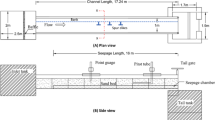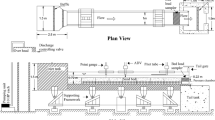Abstract
Alluvial channels with sinuosity follow an altered flow behavior, contradictory to straight flows. At the interface of surface water and groundwater, seepage is a significant phenomenon occurring at the boundary of alluvial channels. The study of turbulence in seepage affected sinuous alluvial channels would thus provide us with a better insight into their hydro-morphological behavior. To address the nature of turbulence in sinuous channel with downward seepage an experimental framework was design. The paper reports the structure of turbulence in the sinuous channel for no seepage and seepage flow. With downward seepage, there is a noticeable shift of Reynolds shear stress at near-bed, which reports more momentum transport. The average streamwise and transverse turbulence intensity increased by 3.8–18.5% and 4–10.6%, respectively with downward seepage. Calculation of Kolmogorov complexity and the Kolmogorov complexity spectrum suggests higher randomness in the outer region, which can be associated with excess momentum transport. In the lower flow depth \( \left( {{\text{z}}/{\text{h}}} = 0.2 \right)\), the randomness in the transverse velocities is higher in the outer region of the bend for about 25% and 38% compared to the central and inner region of the bend, respectively. With downward seepage, randomness increased especially in the outer region. This increase in randomness may report the erosive action in the outer part of the bend. Permutation entropy provided an informative measure to study the complex behavior of the transverse velocity time-series, which we found to be higher in the outer flow zone. For downward seepage, mean of entropy increased across the bend. The turbulent flow alterations and increase in randomness with seepage may be helpful to understand the flow in seepage affected sinuous alluvial channels.









Similar content being viewed by others
References
Abad JD, Garcia MH (2009) Experiments in a high-amplitude Kinoshita meandering channel: 1. Implications of bend orientation on mean and turbulent flow structure. Water Resour Res. https://doi.org/10.1029/2008WR007016
Anwar HO (1986) Turbulent structure in a river bend. J Hydraul Eng 112(8):657–669
Azami H, Escudero J (2016) Improved multiscale permutation entropy for biomedical signal analysis: interpretation and application to electroencephalogram recordings. Biomed Signal Process Control 23:28–41
Bandt C, Pompe B (2002) Permutation entropy: a natural complexity measure for time series. Phys Rev Lett 88(17):174102
Blanckaert K (2002) Secondary currents measured in sharp open-channel bends. In: 5th international conference on hydroinformatics river flow 2002
Blanckaert K, De Vriend HJ (2004) Secondary flow in sharp open-channel bends. J Fluid Mech 498:353–380
Booij R (2003) Modeling the flow in curved tidal channels and rivers. In: Proceedings of the international conference on estuaries and coasts, pp 786–794
Callander RA (1978) River meandering. Annu Rev Fluid Mech 10(1):129–158
Camporeale C, Perona P, Porporato A, Ridolfi L (2007) Hierarchy of models for meandering rivers and related morphodynamic processes. Rev Geophys. https://doi.org/10.1029/2005RG000185
Cao D, Chiew Y-M (2013) Suction effects on sediment transport in closed-conduit flows. J Hydraul Eng 140(5):4014008
Chen X, Chiew Y-M (2004) Velocity distribution of turbulent open-channel flow with bed suction. J Hydraul Eng 130(2):140–148
Crosato A (2008) Analysis and modelling of river meandering. Doctoral thesis, Universitá degli Studi di Padova geboren te Bolzano, Italië. IOS press (ISBN:978-1-58603-915-8)
de Vriend HJ, Geldof HJ (1983) Main flow velocity in short river bends. J Hydraul Eng 109(7):991–1011
Deshpande V, Kumar B (2016) Turbulent flow structures in alluvial channels with curved cross-sections under conditions of downward seepage. Earth Surf Proc Land 41(8):1073–1087
Dietrich WE, Dungan Smith J, Dunne T (1979) Flow and sediment transport in a sand bedded meander. J Geol 87(3):305–315
Esfahani FS, Keshavarzi A (2011) Effect of different meander curvatures on spatial variation of coherent turbulent flow structure inside ingoing multi-bend river meanders. Stoch Environ Res Risk Assess 25(7):913–928
Esfahani FS, Keshavarzi A (2013) Dynamic mechanism of turbulent flow in meandering channels: considerations for deflection angle. Stoch Environ Res Risk Assess 27(5):1093–1114
Ferenets R et al (2006) Comparison of entropy and complexity measures for the assessment of depth of sedation. IEEE Trans Biomed Eng 53(6):1067–1077
Goring DG, Nikora VI (2002) Despiking acoustic doppler velocimeter data. J Hydraul Eng 128(1):117–126
Graf WH, Blanckaert K (2002) Flow around bends in rivers. In: 2nd international conference new trends in water and environmental engineering for safety and life: eco-compatible solutions for aquatic environments, pp 1–9
Henry M, Judge G (2019) Permutation entropy and information recovery in nonlinear dynamic economic time series. Econometrics 7(1):10
Herrera-Granados O, Kostecki SW (2017) Experimental study of the influence of small upward seepage on open-channel flow turbulence. J Hydraul Eng 143(8):6017009
Hu J, Gao J, Principe JC (2006) Analysis of biomedical signals by the Lempel–Ziv complexity: the effect of finite data size. IEEE Trans Biomed Eng 53(12):2606–2609
Ichimiya M, Nakamura I (2013) Randomness representation in turbulent flows with Kolmogorov complexity (in mixing layer). J Fluid Sci Technol 8(3):407–422
Lade AD, Mihailović A, Mihailović DT, Kumar B (2019) Randomness in flow turbulence around a bridge pier in a sand mined channel. Physica A Stat Mech Appl 535:122426
Leopold LB, Langbein WB (1966) River Meanders. Sci Am 214(6):60–73
Li X, Ouyang G, Richards DA (2007) Predictability analysis of absence seizures with permutation entropy. Epilepsy Res 77(1):70–74
Li X, Cui S, Voss LJ (2008) Using permutation entropy to measure the electroencephalographic effects of sevoflurane. Anesthesiol J Am Soc Anesthesiol 109(3):448–456
Li Y et al (2018) A fault diagnosis scheme for planetary gearboxes using adaptive multi-scale morphology filter and modified hierarchical permutation entropy. Mech Syst Signal Process 105:319–337
Liu XX, Chiew Y-M (2012) Effect of seepage on initiation of cohesionless sediment transport. Acta Geophys 60(6):1778–1796
Maclean AG (1991) Open channel velocity profiles over a zone of rapid infiltration. J Hydraul Res 29(1):15–27
McKeogh EJ, Kiely GK (1989) Experimental study of the mechanisms of flood flow in meandering channels. In: Proceeding of 23rd IAHR Congress, Ottawa, Canada, pp 491–498
McLelland SJ, Nicholas AP (2000) A new method for evaluating errors in high-frequency ADV measurements. Hydrol Process 14(2):351–366
Michael S (2005) Applied nonlinear time series analysis: applications in physics, physiology and finance. World Scientific, Singapore
Mihailović DT, Nikolić-Dorić E, Drešković N, Mimić G (2014) Complexity analysis of the turbulent environmental fluid flow time series. Physica A Stat Mech Appl 395:96–104
Mihailović D, Mimić G, Drešković N, Arsenić I (2015a) Kolmogorov complexity based information measures applied to the analysis of different river flow regimes. Entropy 17(5):2973–2987
Mihailović DT, Mimić G, Nikolić-Djorić E, Arsenić I (2015b) Novel measures based on the Kolmogorov complexity for use in complex system behavior studies and time series analysis. Open Phys 13:1. https://doi.org/10.1515/phys-2015-0001
Mihailović D et al (2017) Randomness representation of turbulence in canopy flows using Kolmogorov complexity measures. Entropy 19(10):519
Oldenziel DM, Brink WE (1974) Influence of suction and blowing on entrainment of sand particles. J Hydraul Div 100(7):935–949
Omidvarnia A, Mesbah M, Pedersen M, Jackson G (2018) Range entropy: a bridge between signal complexity and self-similarity. Entropy 20(12):962
Pincus SM (1991) Approximate entropy as a measure of system complexity. Proc Natl Acad Sci 88(6):2297–2301
Pincus S (1995) Approximate entropy (ApEn) as a complexity measure. Chaos Interdiscip J Nonlinear Sci 5(1):110–117
Radhakrishnan N, Wilson JD, Loizou PC (2000) An alternate partitioning technique to quantify the regularity of complex time series. Int J Bifurc Chaos 10(07):1773–1779
Rao AR, Sreenivasulu G (2009) Design of plane sand-bed channels affected by seepage. Period Polytech Civ Eng 53(2):81–92
Richardson JR, Abt SR, Richardson EV (1985) Inflow seepage influence on straight alluvial channels. J Hydraul Eng 111(8):1133–1147
Richman JS, Moorman JR (2000) Physiological time-series analysis using approximate entropy and sample entropy. Am J Physiol Heart Circul Physiol 278(6):H2039–H2049
Rozovskiῐ IL (1957) Flow of water in bends of open channels. Academy of Sciences of the Ukrainian SSR, Kiev
Schumm SA (1963) Sinuosity of alluvial rivers on the Great Plains. Geol Soc Am Bull 74(9):1089–1100
Sen AK (2009) Complexity analysis of riverflow time series. Stoch Environ Res Risk Assess 23(3):361–366
Sharma A, Mihailović DT, Kumar B (2018) Randomness representation of turbulence in an alluvial channel affected by downward seepage. Physica A Stat Mech Appl 509:74–85
Song Y, Crowcroft J, Zhang J (2012) Automatic epileptic seizure detection in EEGs based on optimized sample entropy and extreme learning machine. J Neurosci Methods 210(2):132–146
Sreenivasulu G, Kumar B, Rao AR (2011) Variation of stream power with seepage in sand-bed channels. Water SA. https://doi.org/10.4314/wsa.v37i1.64115
Srinivasan V, Eswaran C, Sriraam N (2007) Approximate entropy-based epileptic EEG detection using artificial neural networks. IEEE Trans Inf Technol Biomed 11(3):288–295
Sukhodolov A, Kaschtschejewa E (2010) Turbulent flow in a meander bend of a lowland river: field measurements and preliminary results. In: River flow, pp 309–316
Taye J, Barman J, Kumar B, Oliveto G (2020) Deciphering morphological changes in a sinuous river system by higher-order velocity moments. Water 12(3):772
Tennekes H, Lumley JL, Lumley JL et al (1972) A first course in turbulence. MIT Press, Cambridge
Termini D (2009) Experimental observations of flow and bed processes in large-amplitude meandering flume. J Hydraul Eng 135(7):575–587
Thorne CR et al (1985) Direct measurements of secondary currents in a meandering sand-bed river. Nature 315(6022):746
Xu K, Wang J (2017) Weighted fractional permutation entropy and fractional sample entropy for nonlinear Potts financial dynamics. Phys Lett A 381(8):767–779
Yalin MS, da Silva AMF (2001) Fluvial processes. IAHR monograph. International Association for Hydraulic Research, Delft
Zhang X-S, Roy RJ, Jensen EW (2001) EEG complexity as a measure of depth of anesthesia for patients. IEEE Trans Biomed Eng 48(12):1424–1433
Zhou S et al (2018) A novel bearing multi-fault diagnosis approach based on weighted permutation entropy and an improved SVM ensemble classifier. Sensors 18(6):1934
Zhu X, Xu H, Zhao J, Tian J (2017) Automated epileptic seizure detection in scalp EEG based on spatial-temporal complexity. Complexity. https://doi.org/10.1155/2017/5674392
Zunino L et al (2009) Forbidden patterns, permutation entropy and stock market inefficiency. Physica A Stat Mech Appl 388(14):2854–2864
Author information
Authors and Affiliations
Corresponding author
Additional information
Publisher's Note
Springer Nature remains neutral with regard to jurisdictional claims in published maps and institutional affiliations.
Rights and permissions
About this article
Cite this article
Taye, J., Lade, A.D., Mihailović, A. et al. Information measures through velocity time series in a seepage affected alluvial sinuous channel. Stoch Environ Res Risk Assess 34, 1925–1938 (2020). https://doi.org/10.1007/s00477-020-01849-2
Published:
Issue Date:
DOI: https://doi.org/10.1007/s00477-020-01849-2




